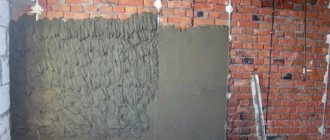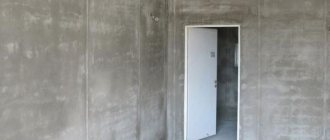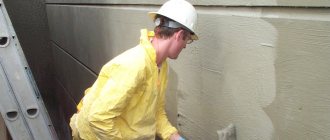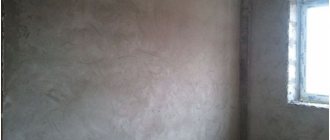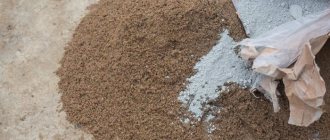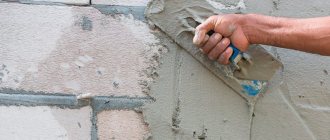When finishing external and internal walls, lime mortar is used. Despite the fact that construction stores offer various modern mixtures for finishing work, this composition is worthy of attention. Let's consider what types of lime mortars are used in each specific case, how to prepare them correctly, and what you need to remember when working with lime.
Lime plaster Source yandex.net
Lime: properties and applications
The positive properties of lime are strength and high adhesive ability. One of its main advantages is its rather low cost, which will ultimately affect the overall construction budget.
Lime added to the plaster solution has antiseptic properties, preventing the formation of mold and mildew on the surface of the walls.
The most important property of lime is its plasticity, which binds all the components of the batch into a homogeneous mass. The finest particles of calcium hydroxide are able to hold water on a rough surface, which reduces friction between the components, creating a so-called “lubricant”. Lime is added to the batch instead of synthetic plasticizers.
There are several basic recipes for preparing the mixture. But before using them, you need to figure out how to extinguish lime.
Lime slaking before mixing
To prepare various types of emulsions, slaked (hydrant) lime - calcium hydroxide - is used. First, it should be extinguished with water. To do this, take a container of a suitable size, for example, a barrel or trough. The container must be rust-free metal, wood or plastic.
Slaking lime in metal containers Source orchardo.ru
Considering that the mass after slaking will increase significantly, the container is taken three times larger than the original volume of quicklime. To slak large quantities of lime, a hole is prepared in the ground. Lumps of lime or ground powder are placed in the container and filled with a sufficient amount of water.
Attention ! When combined with water, a chemical reaction immediately begins - the lime begins to boil rapidly, so you need to be careful not to get burned. Safety measures include special protective clothing, rubber or silicone gloves, and safety glasses.
During the hydration process, cold water is used in the following proportions:
- Extinguishing the fluff – 1 liter of water per 1 kg of lime;
- Slaking of the “dough” - 0.5 liters of water per 1 kg of lime.
Vigorous boiling continues for 36-48 hours, the mass is thoroughly mixed several times. Once hydrated, let sit for two weeks before passing through a sieve to remove any lumps. The hydrant mixture is ready for use.
Lime slaking Source infourok.ru
Finishing
The ideal finish largely depends on the accompanying criteria, where one of the first places is occupied by surface preparation and step-by-step execution of work. The first and main stage is preparing the work area, clearing it of old finishes.
Wall cleaning
If the base is loose, at least two layers of primer .
Primer
Concrete or brick surfaces only need to be primed once. The solution is then mixed with a low-speed drill to obtain a homogeneous mass.
Preparing the mixture
It is advisable to do only two stirrings. Plaster is applied in two ways:
- machine;
Machine method
- manually , but massive potholes are pre-filled.
Manual method
For this, a solution is used that is thicker and more viscous, and it only needs to be dry before applying the main ball. The material described in the article is applied with a spatula or a rule, and it is important to work within the permitted temperature range, which is indicated by the manufacturer on the packaging.
Preparing sand for preparing lime mortar
Several types of sand are used at construction sites:
- River.
- Career.
- Crushed mining waste.
- Quartz sand is used for textured or artistic plaster.
- Barite - for medical institutions and for protecting walls from background radiation.
Sometimes, instead of sand, marble chips are used as filler for decorative surface finishing.
Sand is selected taking into account the fraction and shape of the grains. Coarse grain interspersed with shells is not suitable for forming and leveling walls.
Quarry with a small addition of clay will be an ideal filler for cement-lime plaster. The small cross-section and irregular shape with sharp edges contribute to good adhesion to the surface. A small percentage of clay will prevent the emulsion from settling quickly.
Before mixing, the sand is sifted through a fine sieve with a fine mesh of 3 to 5 mm. This fraction is suitable for starting plaster. For finishing, sift through a sieve with a mesh size of 1-1.5 mm. In the process, pebbles, shells and other foreign inclusions of the large fraction are eliminated. Shell inclusions are suitable for exterior decoration of facades.
River sand, sifted through a sieve Source www.stroyportal.ru
Making sawdust concrete with your own hands
Independent production of lightweight concrete composite is carried out according to the following algorithm:
- The necessary materials are being prepared. There is no need to purchase components in advance. All components can be prepared immediately before production by visiting stores or building materials warehouses, as well as using waste from woodworking enterprises.
- The ingredients are mixed according to the proportions. Mixing of components can be carried out mechanically using a concrete mixer or manually using shovels. Automation of the technological process through the use of a concrete mixer increases productivity, improves mixing intensity, and has a positive effect on product quality.
- Molding is in progress. The group molding process is predominantly used, when the pre-mixed composition is poured into several dozen molds. Single and group forms of collapsible design are used, made of wood 2 cm thick and upholstered in metal or plastic. The use of polyethylene film makes it easier to remove finished products.
- The finished product is dried naturally. The molds are removed 4–5 days after pouring by loosening the wing nuts, removing the threaded rods and disassembling the molding box. The natural drying process lasts, depending on the type of wood, up to three months, during which the moisture concentration is significantly reduced and the product acquires operational strength.
Standard composition of concrete with sawdust: cement-sand mixture, wood shavings, lime (if necessary)
Types of lime mortars
In practice, several mixtures with lime are used:
- Gypsum-lime;
- Lime-clay;
- Cement-lime;
- Terrasite.
The most common cement. With gypsum, the emulsion is used for finishing, when a perfectly flat surface and quick drying are required. And they are used with clay quite rarely - for stoves, fireplaces and mud huts in rural areas. For each recipe, it is necessary to select and prepare all the components.
A type of lime mortar Source talkdevice.ru
Gypsum for mixtures
Lime-gypsum mortar for plastering walls is used only indoors with low humidity.
Advantages of gypsum plaster
This coating is used on ceilings due to its low mass. The walls are covered with a layer of about 5 mm, this allows you to consume significantly less material than when using plaster mortar with cement.
Advantages of coating with this composition:
- Easy vapor conductivity - moisture does not accumulate under the layer of material, good ventilation is ensured.
- After finishing, no varnish, paint or wallpaper is required, as the wall becomes smooth and neat.
- Fire safety - gypsum is not flammable. Therefore there is no risk of fire.
- High plasticity - the mass easily stretches, which is why the wall is covered with a thin layer, reducing material costs and labor costs.
- When heated and wet, no toxic components are released, because the mass consists only of natural ingredients.
Properties of gypsum Source presentacii.ru
Preparation of the solution
Proportion of gypsum mass:
- Dry gypsum powder – 1 part.
- Lime mortar for plaster – 3 parts.
The ingredients are pre-mixed dry in a proportion of 1 part of gypsum to one part of lime. Then both components are mixed to obtain an emulsion.
Preparation of mass from gypsum and lime Source sevparitet.ru
See also: Catalog of construction companies that specialize in finishing and facade materials.
After mixing, the emulsion is transferred to the wall for half an hour. The area is divided into small sections, and the mixture is diluted with water in small portions. If the time is overdue, the batch will have to be thrown away because it will harden and become unusable. On a vertical plane, the mass hardens very quickly, so it must be leveled immediately.
To increase the drying time, drying oil is added to the composition.
Lime-clay coating
For mixing, clay, sand and lime are used. The proportion depends on the fat content of the clay, which has different properties in each area.
Advantages of simple clay coating
Advantages of clay coating:
• Ease of operation.
• Availability of materials.
• Cheap.
• Thermal conductivity.
• Suitable for people suffering from allergies, as it absorbs all odors, leaving the air in the room clean.
Due to the fact that this method is used only at home in the private sector, the preparation and application methods differ.
Preparation of clay-lime mortar
General rules include cleaning the clay from impurities and having sufficient fat content for good plasticity. Before mixing, the clay is poured with water and left for 5 hours to swell. Then add lime paste in a 1:1 ratio and two parts of sand. After thorough stirring, proceed to laying on a vertical plane. Water is periodically added to the mixture to prevent it from drying out.
Example of clay-lime plaster Source myshtukaturka.ru
Component proportions
The standard composition is a proportion of 1 to 4. The first number is lime, the second is sand. In the case of gypsum, the numbers change to 3 to 1, and if you add cement, then the proportions are 2 to 1.
To determine if the mixture is viscous enough, dip a spatula into it. If the liquid mass drains easily from it, it is necessary to add a plasticizer to the composition, because the viscosity is insufficient.
If the spatula has difficulty getting into the mixture, the solution needs to be thinned. Good viscosity is visible in the photo below. You will get excellent adhesion to the wall.
Photo: using a spatula
Video description
Watch the video on how to make clay plaster:
Lime-cement mortar
Lime-cement mortar is considered universal for external and internal work.
Where is lime-cement mortar used?
It is used:
- for finishing the facades of private buildings;
- utility buildings;
- production workshops;
- balconies and loggias;
- residential premises.
Limitations for the use of lime-cement complex:
- In climate zones with high humidity, use on building facades is not recommended.
- In damp basements.
- In wet production workshops.
- For any external and internal work, if the humidity level exceeds 65%.
The material is intended for rough finishing of walls. It is durable and has a fairly long service life.
Proportions and preparation of cement-lime mixture
First, choose a brand of cement. The M400 grade is suitable for processing internal surfaces, and the M500 is suitable for external work. It is better not to take cement that has expired, because the consumption will have to increase, and the quality will be low. For example, brand M500, after a month of storage becomes brand M450, and after six months it loses about a quarter of its astringent and fastening properties.
The proportions of the solution for plastering walls made of cement and sand are shown in the table.
| Cement brand | Cement | Sand | Lime |
| M400 | 1 bucket | 4 buckets | 0.2 buckets |
| M500 | 1 bucket | 5 buckets | 0.2 buckets |
Proportions for lime-cement plaster Source multiurok.ru
Requirements for masonry mixture
The requirements for masonry mortars are described in detail in GOST 28013-98. According to this document, the following requirements apply to mortar mixtures:
- the composition must have a high degree of adhesion to brick and other substrates;
- withstand large amounts of freezing and defrosting;
- to ensure that the masonry does not collapse under the influence of atmospheric influences and temperature changes, the masonry mixtures must have high water resistance;
- due to the plasticity of the mortar, during the laying process, it becomes possible to timely adjust the position of the masonry material, which significantly increases the quality and productivity of the work;
- water-retaining properties prevent decomposition of the mixture and precipitation of heavy fractions;
- the strength characteristics of the composition are decisive in the calculation of building structures. This parameter shows what maximum loads the material can withstand. The brand of the solution reflects its strength in kgf/cm2.
Failure to comply with these requirements leads to the formation of cracks in the brickwork, increased consumption of the mortar mixture, increased thickness of the joints and reduces work productivity.
Video description
The video will show how to cheaply plaster the walls of a house with lime-cement mortar:
Heavy cement-lime mortar is used for exterior work. It is waterproof and protects the building from low temperatures. For internal ones, light ones with a lot of sand are suitable. It is taken into account that lightweight plasters last less and crumble faster. The frost resistance of such mixtures is lower than that of heavy ones.
Cement-lime mortar for plaster takes a long time to dry, so make a large batch at once. The finished emulsion is left for 15 minutes to “ripen”, mixed again and applied to the walls. If a large volume is prepared, stir the mixture from time to time to maintain homogeneity.
Lime differs in the composition of carbonate impurities. Therefore, before starting the main work on leveling the plane, test batches are made and tested in small areas to determine the optimal proportions of cement mortar for plastering walls.
Test batch for plastering Source yandex.net
Terrasite plaster
Designed for decorative finishing of facades. It has fast setting, so the entire composition is prepared dry and mixed with water in small portions, immediately applied to the facade. After drying, the decorative parts are rubbed down to expose the colored filling.
The complex includes the following components:
- Lime fluff.
- Mica.
- Marble chips.
- Broken ceramics or glass.
- White cement.
- White sand.
- Kohler (pigment).
Application of ready-made terrazite plaster Source stroyfora.ru
Varieties
There are several recipes for making lime plaster. The difference between the compositions lies in the use of additional components that act as a filler and plasticizer. For interior decoration, the following materials are added to the lime mortar:
- Cement. If you make a solution of lime with the addition of cement, you will get a reliable and moisture-resistant coating. One of the options for use is finishing basements with high humidity and lack of sunlight. Please note that lime-based cement plaster is not used for wall finishing in new buildings. Considering the cost of materials, it turns out to be too expensive. But for repair and restoration work, such a mixture will be indispensable.
- Gypsum. The optimal option for finishing wooden surfaces, however, requires certain work skills. The fact is that gypsum has a quick setting, so the solution is made in small portions and immediately applied to the surface.
- Sand. This is the most common type of lime plaster. Even a beginner can prepare the mixture and perform finishing work. In addition, the cost of lime-based sand plaster is surprisingly low, which may explain its popularity. Please note that before starting work, the sand must be sifted and washed, otherwise it will not be possible to obtain an even layer of plaster.
USEFUL INFORMATION: Soundproofing and sound-absorbing panels for walls
- Clay. The use of this material as a plasticizer is extremely rare. This is explained by the specific application: leveling and securing clay surfaces.
Plastering walls
The finished finishing solution is applied to the surface. During hardening, the layer contracts (shrinkage). As a result, cracks appear and the plaster layer lags behind the base. To avoid this situation, metal reinforcing mesh is traditionally used. This technology is proven and reliable. At the same time, it has a number of disadvantages, including the labor intensity and complexity of the production process.
Modern methods include preliminary priming with an adhesive composition to ensure high-quality fixation of the mass on a vertical plane. With this technique, reinforcing mesh is not required. The plaster mixture is applied immediately, preventing the primer from drying out.
Automatic wall plastering Source static.ex-in.online
Video description
Watch in the video how mechanized plastering of walls occurs:
Before throwing the material onto the plane, beacons are placed so that after drying you can see how much shrinkage has occurred. Mixture consumption per 1 square meter with a layer thickness of 5 mm is 5-6 kg. If the thickness is 10 mm, the consumption will accordingly be 10-12 kg per square meter.
Using a spatula or trowel, apply the finished emulsion onto a grater or rule, moving it from the bottom to the top for uniform distribution over the plane.
Apply onto small areas with a spatula or trowel. After spreading over the entire area, the plaster is finally leveled with a trowel. Large volumes of work are divided into separate sections so that the mixture does not fall off and you do not have to do everything again.
The finished plaster lays down beautifully and evenly Source tekato.ru
Drying of the finished layer takes several days, sometimes it takes two weeks for the cement-lime mortar to completely dry and shrink. It is advisable that during this period the air temperature does not exceed 10-20 degrees. At a comfortable temperature, moisture evaporates gradually, which prevents cracking and peeling.
In hot weather, it dries quickly, first microcracks appear, then large ragged cracks. At elevated temperatures, it is advisable to shade the wall or cover it with polyethylene. Needless to say, sub-zero temperatures are unacceptable for the drying process.
After drying, apply a thin finishing layer and dry again. The wall is ready for painting or other decorative finishing.
Wall alignment Source diy.obi.ru
Application instructions
All work is done gradually. You need to create three layers, each of which has its own functional purpose. This is the only way to achieve optimal results.
The technology is as follows:
- Creating the first layer, spraying. Its purpose is to improve the adhesion of the first layer to the wall, as well as to fill all the voids and cracks to avoid the formation of voids. The optimal consistency is creamy, not too thick. The plaster is spread over the entire wall with a trowel. There is no need to level the layer. This process can be mechanized with a special spraying device. The layer thickness is small.
- The second layer is soil. He's the main one. Its thickness is up to 50 mm. The solution is doughy, thicker than for spraying. Application occurs using trowels or trowels. Excess solution will be removed by the rule. They also check the evenness of the surface.
- The final layer is the covering. It eliminates all defects, chips and creates a smoother and more uniform surface. The thickness of the mixture resembles a spray solution. Application occurs on a damp wall, the layer thickness is several millimeters. At the end, you need to treat the layer with a float to remove defects and make the wall smoother.
This was a technical process of applying limestone plaster. If you practice, you can do work inside or outside quickly and efficiently. This mixture has many advantages, including versatility, vapor permeability, plasticity and ease of application. And if everything is done correctly, the finish will last for decades.
